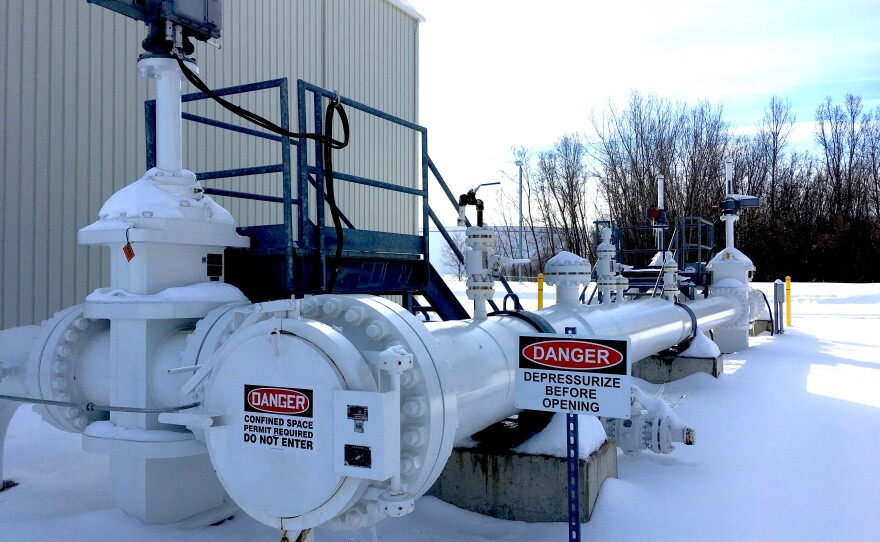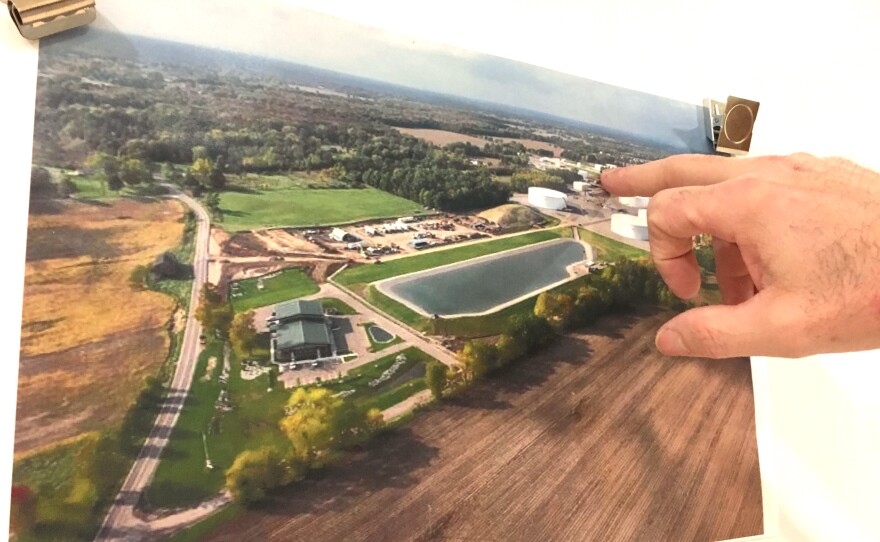As the recent disaster in Massachusetts shows, pipeline problems can cause fatal explosions. But in Michigan, it’s the impact pipelines might have to our increasingly threatened water supplies that is drawing most of the attention. This is the third of our “Green Room” series on pipelines.
David Fair: This is 89-1 WEMU and welcome to this month’s edition of “The Green Room.” I’m David Fair, and, today, we continue our series on Michigan’s growing web of oil and gas pipelines. We’ve been discussing everything from the 65-year old “Line 5” pipeline running through the Straits of Mackinac, to the new Nexus gas pipeline, which is scheduled to begin running today in Washtenaw County. In this 3rd piece of our pipeline series, Barbara Lucas heads into “The Green Room" to ask: Are the risks from pipelines to our drinking water worth taking? And, what is being done to minimize those risks?
Drumming and chanting, zooming cars.
BL: I’m at the tip of Michigan’s Lower Peninsula, under the Mackinac Bridge, with Jannan Cornstalk.
Jannan Cornstalk: I am a citizen of the Little Traverse Bay Bands of Odawa Indians.
BL: She’s organized a flotilla of kayakers—over a hundred have shown up here today—to call for the shut down of the Line 5 pipeline. It’s owned by Enbridge, and lies at the bottom of the S traits between Lake Michigan and Lake Huron.
Cornstalk: Forty million people depend on this water for drinking, for economic reasons, for spiritual reasons. We have tribal fishermen that fish in these waters.
BL: This is the fourth year of the Pipe Out gathering. Cornstalk is encouraged by the increasing, bipartisan calls for action. But she’s getting impatient, in light of Line 5’s aging condition. Not to mention last April’s anchor strike that damaged utility lines uncomfortably close to Line 5.
Cornstalk: Don't say, ‘I'm going to shut it down.’ People have been saying that all along. Well, really, how are you going to do that? I want to know, blow by blow, how are you going to do that?
BL: Republican State Senator Rick Jones was at last year’s gathering, but had to cancel his appearance here today. So I caught up with him by phone. He tells me his mother-in-law lived on the Kalamazoo River near Marshall, until the 2010 Enbridge oil spill.
Senator Rick Jones: She had to sell her home to Enbridge Company.
BL: Senator Jones feels a risk to the Great Lakes is a risk Michigan should not accept. Instead of putting Line 5 in a tunnel, he would rather see it rerouted, out of Michigan.
Jones: Most of this product goes to Sarnia, and in Sarnia they refine it. It's Canadian oil. So we have Canada taking a shortcut through Michigan to get to their refinery.
BL: But according to Enbridge spokesperson Ryan Duffy, Michigan needs Line 5.
Ryan Duffy: Thirty percent of the crude oil on line 5 goes to Detroit area refineries. And so that’s used back in Michigan, so that’s used for cars and for jet fuel and all those kinds of things. We supply 55 percent of the propane use statewide. Sixty-five percent in the U.P. So they're relying on a consistent supply that's affordable and that is reliable. So Enbridge, in particular, is the reason it is reliable and affordable.
BL: On Sept. 12th, the National Wildlife Federation released an independent report saying instead of Line 5, Michigan’s propane needs could be met by trucking—with a price increase of 5 cents a gallon. But trucking, Senator Jones acknowledges, is not as safe as pipelines. Regardless, he feels the threat to the Great Lakes is too great.
Jones: It's the best natural resource that Michigan has, and we should do everything to protect it.
BL: Beth Wallace is a pipeline safety specialist at the National Wildlife Federation. We meet at their office in Ann Arbor. The Enbridge oil spill in the Kalamazoo River isn’t far from where she grew up. That disaster prompted her to research and write “Sunken Hazard,” the 2012 report that brought national attention to Line 5. I ask her…
BL: How many crossings of pipelines over water are there in Michigan?
Beth Wallace: I know that Enbridge alone, over wetlands, rivers and streams, there's around 400 for just Line 5: The St. Clair River…
BL: The St. Clair River is connected to the Detroit River, the source of drinking water for much of Southeast Michigan.
Wallace: …Au Sable river, Straits of Mackinac, obviously, and then all throughout most of the wetlands in the northern part of Michigan.
BL: Wallace points out that the Enbridge spill started in a wetland, which was in a 100-year flood. So it spilled over into a creek, which connects to the Kalamazoo River.
Wallace: So an incident can really occur anywhere, especially with the weather events that we are having because of climate change.
BL: As vice president of the board of the national organization called the Pipeline Safety Trust, Wallace is committed to making pipelines safer.
Wallace: This does not need to be a risk for Michigan, especially in light that we have a huge drinking water issue across the entire state. We cannot continue to go down this path where we continue to add pressure to our drinking water sources. It’s just… it’s a huge problem.
BL: Meanwhile, representatives from pipeline companies assure me multiple safety measures are in place throughout Michigan. Steve Hopf is a pipeline expert with DTE Energy. With Enbridge, DTE owns the Nexus gas pipeline, which is aiming to begin flowing through Washtenaw County by September 28th.
Steve Hopf: We have foot patrols, if you will, to observe the pipeline corridor—at a real time basis—walking the corridor. We also do aerial patrols weekly of our pipeline infrastructure. And the intent of the aerial patrols is to get a good look from above that any change in vegetation or other characteristics that that would lead us to believe there could be something that we need to explore a little bit further.
BL: He says not only do they regularly inspect pipelines from the outside, but from the inside too.
Hopf: Like an X-ray almost, from the interior of the pipeline to ensure that the integrity on the inside of the pipeline is at its utmost—just like we do on the exterior of the pipeline.
BL: Is that with those things called pigs?
Hopf: Yes it is.
BL: I keep hearing about these pipeline inspection gadgets, or “pigs,” that check for pipeline problems. I can’t picture them.
Rusty Smith: I’ll pull it around so you can see it a little bit better.
BL: To learn more, I’m being given a tour of Enbridge Energy’s storage and terminalling facility in Stockbridge. Manager Rusty Smith shows me Line 79 that transports oil to Washtenaw County.
Smith: This is where we send the pipeline tools into Line 79. This is one of our tool traps—pig traps—that we talked about.
BL: Finally, I get to see a “pig”! We stop to look. Some of them, he says, are what they call “smart pigs.”
Smith: It’s got all kinds of computers and electronics in it and it will look for anything of corrosion, dents, any abnormality in the pipeline. It'll tell you where that's at. It's got a GPS tracker on it. And so you can get exactly where the indication is on the pipeline.
BL: Pipeline corrosion caused the crack, which caused the spill, in the Kalamazoo River. The Enbridge control center in Edmonton Canada misinterpreted the warnings about the spill and let it go on for 17 hours. Enbridge spokesperson Ryan Duffy says a lot has changed since then.
Ryan Duffy: So you know it starts with the materials. We have a cathodic protection running through these pipes at all times, so that prevents corrosion on the pipes. And our inspection and maintenance programs, they are 24-hour monitored from our control center up in Edmonton. So they're watched at all times.
BL: He is confident the human error which caused the devastation in the Kalamazoo River will not be repeated.
Duffy: Every new employee in the company gets a ring that's made out of a piece of Line 6B that ruptured. And so every employee, even if we weren't there, which I wasn't there, but all employees are given that reminder to always remember what happened and never make those mistakes.
BL: He says safety awareness permeates everything at Enbridge.
Duffy: Even if it’s just an office meeting like this, we start every meeting with a safety moment. And so then we've made huge changes in safety and inspections and emergency response, and just really have been transformed.
BL: Duffy and manager Smith tell me Enbridge has restored the 35 miles of the Kalamazoo River, and removed long-submerged junk in the process.
Smith: It's better than it's ever been. I’ve heard of a firefighter on a local fire department in the Albion area, and I’ve heard from local residents in Albion, that they sometimes have said “I wish that would happen in Albion, we'd clean the river up there.” But you know obviously they don't really want that to happen, they just want the river cleaned up.
Sounds of Pipe-Out gathering (drumming, cars on Mackinac Bridge).
BL: We all appreciate clean water. But how to achieve that—when it comes to pipelines—is where things really get muddy. In “The Green Room,” I’m Barbara Lucas, 89 One, WEMU News.
Fade out sounds of Pipe-Out.
David Fair: Join us in upcoming months for more of our “Green Room” series on pipelines. The Green Room is heard on the last Friday of each month and you’ll find our archive of shows at wemu.org. I’m David Fair and this is 89 One WEMU FM and WEMU H-D One Ypsilanti.
Resources:
Nexus Gas Transmission Pipeline
DTE on Natural Gas Pipeline Safety
“Sunken Hazard,” National Wildlife Federation, 2012.
Non-commercial, fact based reporting is made possible by your financial support. Make your donation to WEMU today to keep your community NPR station thriving.















